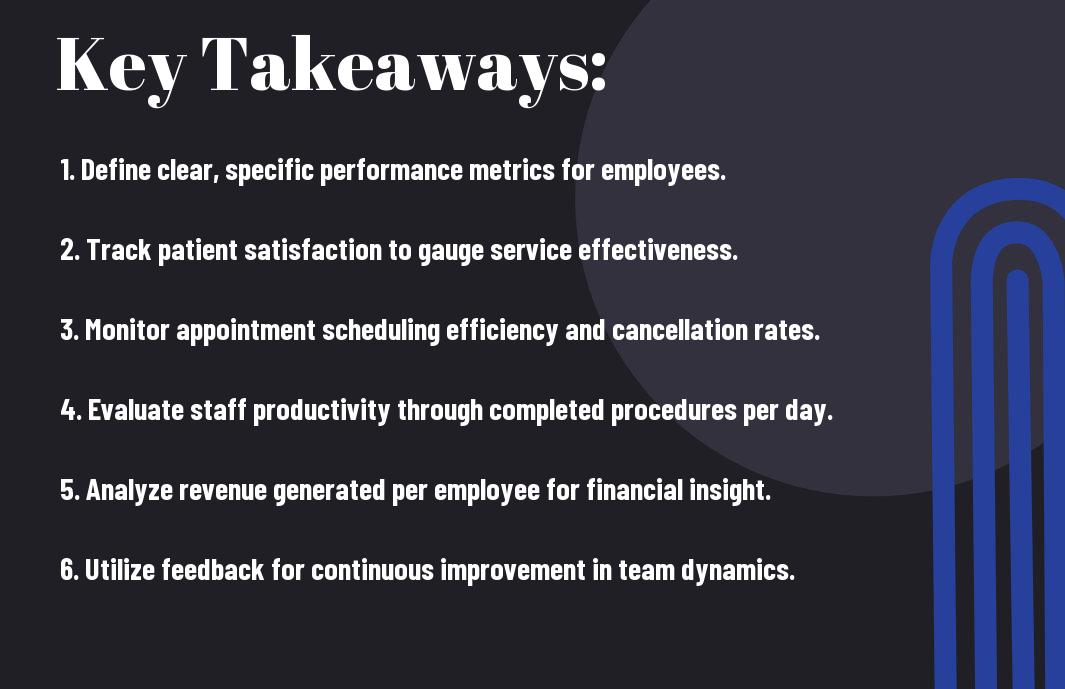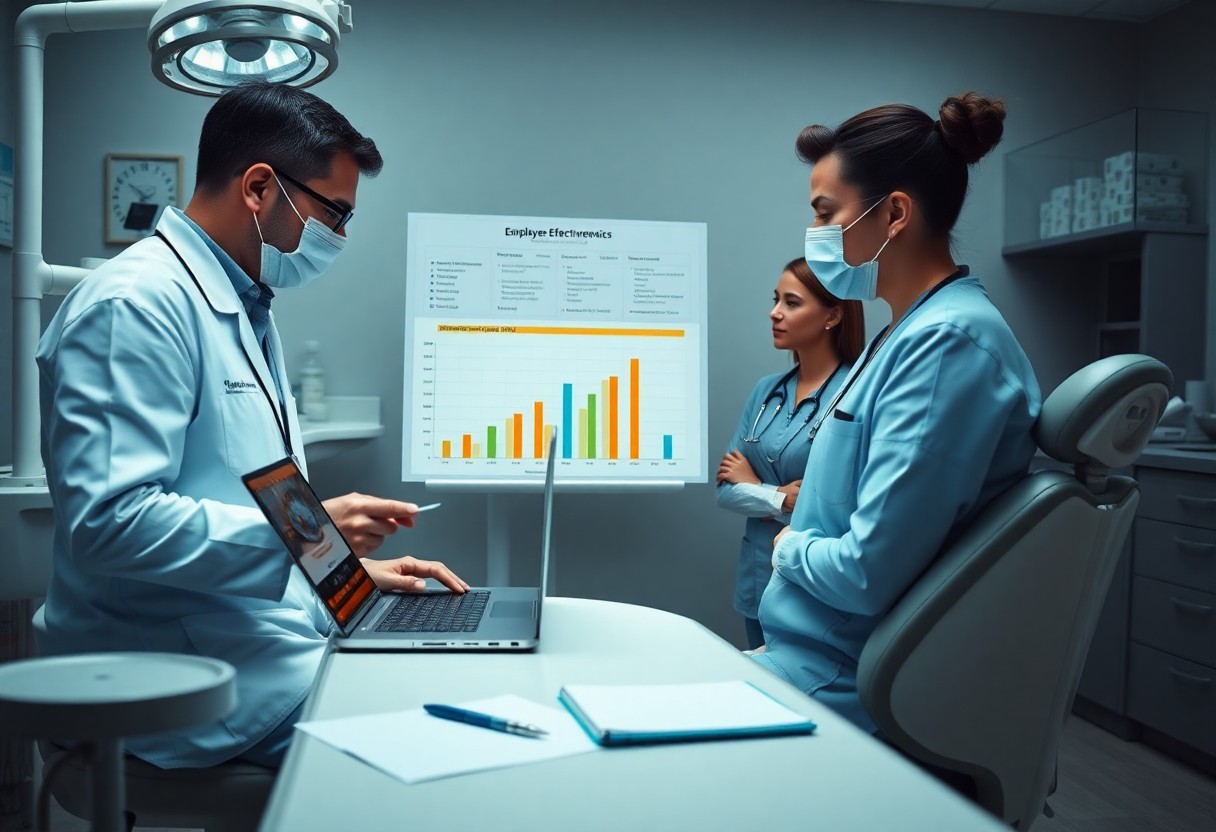How to Measure Employee Effectiveness in Dental Offices
Effectiveness is paramount in any dental office, and as I navigate the intricacies of employee performance, I find that implementing Key Performance Indicators (KPIs) is crucial for ensuring that your team is working optimally. By measuring employee productivity, patient satisfaction, and operational efficiency, you can identify areas of strength and opportunities for growth. In this blog post, I will explore the crucial KPIs that can drive success, enhance your practice’s overall effectiveness, and ultimately improve patient care.
Key Takeaways:
- Identifying and tracking specific Key Performance Indicators (KPIs) can enhance overall employee productivity and accountability in dental offices.
- Data-driven insights from KPIs can inform training and development needs, ensuring staff have the right skills to meet organizational goals.
- Effective communication of performance metrics can foster a culture of transparency and motivation among dental office employees.
- Regular assessment of KPIs allows for timely adjustments in practices, leading to improved patient care and operational efficiency.
- Establishing clear benchmarks for success through KPIs helps align employee efforts with the strategic objectives of the dental practice.

Understanding Key Performance Indicators
Before entering into the specifics, it’s crucial to grasp the concept of Key Performance Indicators (KPIs) and their relevance within dental offices. KPIs serve as measurable values that demonstrate how effectively a practice is achieving key business objectives. By consistently tracking these indicators, I can make informed adjustments to enhance overall performance and employee effectiveness.
Definition of Key Performance Indicators
Among the various metrics utilized in businesses, Key Performance Indicators, or KPIs, are specific measurable values that assess progress towards goals. For dental practices, these might include metrics related to patient satisfaction, appointment cancellations, or revenue per patient. Effectively leveraging KPIs allows you to pinpoint areas that require improvement and track success over time.
Importance of KPIs in Dental Practices
About 90% of dental practices that utilize KPIs report improved operational efficiency. Tracking KPIs in your practice helps you identify strengths and weaknesses, ensuring you focus on enhancing areas that directly affect patient care and satisfaction. With clear visibility into performance metrics, I can align my team’s efforts with the practice’s goals, ultimately leading to heightened productivity and a better patient experience.
Dental practices that actively monitor KPIs can drive significant changes in operational strategy, allowing for better resource allocation and optimized employee performance. When you understand which metrics truly reflect your practice’s health, you can reduce inefficiencies and make data-backed decisions. By focusing on KPIs, you enhance not just individual performance but also the overall quality of care delivered to your patients, fostering a culture of continuous improvement.

Key Performance Indicators for Employee Effectiveness
If you want to truly understand the performance of your dental team, focusing on the right Key Performance Indicators (KPIs) is necessary. These metrics can help you evaluate your employees’ effectiveness in ways that drive improvement and enhance patient care. By analyzing these KPIs, you can identify areas where your team excels and where additional training or support may be needed to optimize performance.
Link Between Staff Performance and Patient Satisfaction
Indicators related to patient interaction are vital for gauging the effectiveness of your dental staff in delivering a satisfactory patient experience. These include patient satisfaction scores, the number of patients returning for follow-ups, and average treatment acceptance rates. High scores in these areas often point to an effective, engaged team that prioritizes patient relationships.
Operational Efficiency and Practice Growth
Around the dental office, administrative efficiency is a reflection of how well your team handles scheduling, billing, and records management. Metrics such as appointment no-show rates, patient wait times, and the turnaround time for processing insurance claims provide insights into the operational effectiveness of your administrative staff.
Metrics in this context are critical for identifying bottlenecks that could hinder operational flow. For instance, a high appointment no-show rate might indicate poor communication or follow-up practices. Likewise, extended patient wait times can lead to dissatisfaction and lost business. Tracking the turnaround time for insurance claims is equally important, as delays can affect cash flow and patient trust. By measuring these indicators, you can make informed changes to improve overall efficiency in your dental practice.

Metrics for Assessing Clinical Performance
Many dental offices strive to measure the effectiveness of their clinical teams through specific metrics. Evaluating clinical performance is vital not just for improving outcomes but also for ensuring consistent patient care. By implementing key performance indicators tailored to clinical efficacy, you can gain valuable insights into your practice’s overall health and areas that may require attention.
Treatment Accuracy and Compliance
Around 90% of patients expect successful treatment outcomes in their dental care, making treatment success rates a vital metric. By tracking these rates, I can identify trends in successful procedures, assess staff skills, and provide targeted training when necessary.
Compliance with Protocols
Around 80% of dental errors occur due to non-compliance with established protocols. Monitoring compliance is vital to safeguard patient health and maintain the integrity of your practice. Non-compliance can lead to significant legal repercussions and damage your reputation.
Assessing compliance with protocols involves reviewing adherence to standard operating procedures, infection control measures, and treatment guidelines. Regular audits can provide insight into how well your team follows these protocols. By focusing on educating staff and addressing areas of non-compliance, you can enhance patient safety and improve overall treatment quality. Fostering a culture of accountability is key to building trust with your patients and ensuring consistent care in your practice.
Customer Satisfaction as a Performance Indicator
Now, focusing on customer satisfaction is crucial for understanding employee effectiveness in your dental office. By assessing this metric, you gain insight into how well your team meets patient needs and expectations. For more information on how to implement and evaluate these metrics, visit Key Performance Indicators for Dental Practices.
Patient Feedback and Surveys
Customer feedback is a direct reflection of your practice’s quality. Gathering opinions through surveys allows you to pinpoint areas for improvement, ensuring your staff delivers exceptional service. Deploying tools for regular feedback facilitates open communication and fosters a positive patient experience.
Retention Rates and Referral Patterns
Surveys that track your practice’s retention rates and referral patterns can illuminate how satisfied patients are with your services. Understanding these metrics allows you to gauge the effectiveness of your team and determine if they’re nurturing lasting relationships with patients. Analyzing this data helps identify trends that can lead to improvements in both patient care and employee performance.
With a sharp focus on retention rates, you’ll be able to see your practice’s growth and identify areas of concern. High retention signals that your team connects well with patients, while low referral patterns may indicate issues needing addressing. Engaging with patients who return and refer others demonstrates a positive reception of your staff’s efforts. Addressing feedback from those who aren’t as satisfied can lead to transformative changes in your approach, ultimately boosting both employee and patient satisfaction.
Training and Development as KPIs
Once again, assessing employee effectiveness in dental offices requires a focus on training and development as key performance indicators. By offering continuous training opportunities, I can ensure that my staff is not only equipped with the latest dental techniques but also motivated to improve their professional skills. This in turn leads to higher quality patient care and a more efficient office environment, ultimately translating to better business performance.
Continuing Education and Skills Improvement
For dental professionals, continuing education and skills improvement are crucial to stay current with evolving industry standards and technologies. By investing in workshops, seminars, and online courses, you provide your team the tools they need to enhance their expertise and adapt to new practices. This not only boosts their confidence but also increases the overall competency of your dental office.
Employee Satisfaction and Engagement
Development of your dental team cannot be understated, as employee satisfaction and engagement play a major role in their effectiveness. A happy and motivated staff is more likely to provide exceptional patient care and foster a welcoming office atmosphere. When employees feel valued, they are inclined to engage more actively with their work and contribute to a positive office culture.
Further, keeping your team satisfied and engaged leads to lower turnover rates, which can be costly and disruptive for your practice. Actively seeking feedback on their experiences and incorporating their suggestions can significantly enhance their job satisfaction. This creates a supportive environment where employees feel recognized and are more committed to achieving organizational goals. In turn, this translates into improved patient interactions and greater overall efficiency for your dental practice.
Implementing and Monitoring KPIs in Dental Offices
Not only is it imperative to establish KPIs, but actively implementing and monitoring them is what drives continuous improvement in your dental practice. You need a systematic approach to ensure that every team member understands their role in achieving these goals, fostering a culture of accountability and excellence. Regular reviews and adjustments will allow you to respond swiftly to changing circumstances and maintain optimal performance across all areas of your operation.
Setting Up a KPI Framework
Framework development starts with identifying the specific metrics that align with your practice’s vision and goals. I recommend involving your team in this process, ensuring that everyone is aligned and invested in the set objectives. Clearly defined KPIs should be measurable, relevant, and realistic, allowing you to track progress and make informed decisions.
Tools and Technologies for Measurement
Measurement tools are vital for effectively tracking KPIs in your dental office. Leveraging modern technology, such as practice management software, enables accurate data collection and analysis. These systems can automate reporting, saving you valuable time while providing comprehensive insights into your key performance indicators.
Indeed, utilizing the right tools enhances your ability to monitor KPIs. For instance, practice management software can generate real-time reports and analytics, allowing you to quickly assess performance trends. Additionally, patient relationship management tools can improve communication, ensuring high patient satisfaction. Furthermore, regular audits using these technologies can help you identify areas for improvement, creating a cycle of continuous growth and engagement within your team.
Conclusion
The insights I’ve shared on measuring employee effectiveness through Key Performance Indicators (KPIs) in dental offices highlight the importance of tracking productivity and engagement. By identifying and implementing the right KPIs, you can enhance your team’s performance and ultimately improve patient care. I encourage you to evaluate your current practices and establish relevant metrics that align with your office’s goals, ensuring a more efficient and effective workplace.
FAQ
Q: What are Key Performance Indicators (KPIs) in the context of dental offices?
A: Key Performance Indicators (KPIs) are measurable values that demonstrate how effectively dental offices are achieving their business objectives. In a dental practice, KPIs help assess employee effectiveness, overall operational efficiency, patient satisfaction, and financial performance. Examples include patient retention rates, treatment completion rates, and staff productivity metrics.
Q: Why is it important to measure employee effectiveness in dental offices?
A: Measuring employee effectiveness is vital for identifying areas of strength and opportunities for improvement. It enables dental practices to enhance team performance, provide better patient care, increase efficiency, and ultimately drive practice profitability. By using KPIs, management can define clear objectives and motivate staff to achieve them.
Q: What KPIs should dental offices track to assess employee performance?
A: Dental offices should consider tracking the following KPIs:
1. Patient wait times
2. Treatment acceptance rates
3. Average patient turnover
4. Number of procedures completed per employee
5. Patient feedback scores
6. Staff training completion rates
7. Revenue generated per employee.
Gathering data on these KPIs can provide valuable insights into employee effectiveness.
Q: How can KPIs impact patient satisfaction in a dental office?
A: KPIs have a direct impact on patient satisfaction as they highlight areas where service can be improved. For example, tracking patient wait times can help identify bottlenecks in the schedule, leading to adjustments that reduce delays. Increased treatment acceptance rates indicate effective communication and rapport between staff and patients, thereby enhancing their overall experience.
Q: How often should dental offices review their KPIs?
A: Dental offices should review their KPIs regularly, ideally on a monthly or quarterly basis. Frequent reviews allow practice management to identify trends, measure progress towards goals, and make timely adjustments to strategies or workflows. Additionally, ongoing assessment fosters a culture of accountability and continuous improvement among employees.
Q: What tools or software can help dental offices track KPIs?
A: There are numerous tools and software options available for tracking KPIs in dental offices. Practice management software such as Dentrix, Eaglesoft, and Open Dental often come with built-in reporting features. Additionally, specialized analytics solutions like Dental Intelligence or Practice Analytics can provide deeper insights into performance metrics, allowing for data-driven decision-making.
Q: How can dental offices encourage employees to focus on achieving KPIs?
A: Dental offices can encourage employees to focus on KPIs by fostering an environment of transparency and goal-setting. Regularly sharing performance data, recognizing achievements, providing training and resources, and establishing incentive programs tied to KPI performance can motivate staff. It’s important to engage employees in the process by seeking their input and offering opportunities for professional development.




